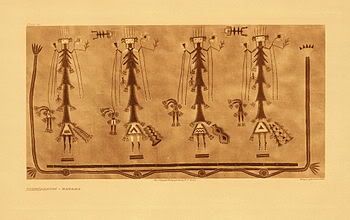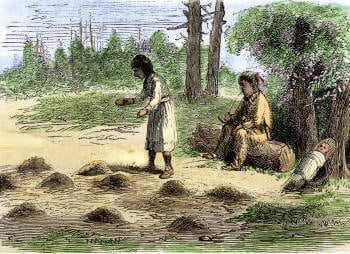Makah Whaling
The area along the Pacific Coast north of California and between the Cascade Mountains and the ocean is the home to many Indian nations who traditionally based their economy on the use of sea coast and river ecological resources. This is a region of immense physical complexity, an oceanic environment clothed in limitless forest covering the rugged and precipitous mountain ranges. The traditional Indian nations located in this region were oriented toward the sea and made large sea-going canoes.
Among the sea mammals hunted by the Indian people were whales. Whales provided a significant range of importance resources, including meat, bone, baleen, sinew, and gut. The most commonly hunted whales were the California gray whale and the humpback whale. Hunting whales provided some significant challenges to the First Nations people of the Northwest Coast.
One of the whale-hunting Northwest Coast tribes is the Makah who located on the Olympic Peninsula in present-day Washington. The name “Makah” was given to them by the neighboring S’Klallam and refers to the generosity of their feasts. The Makah traditionally measured their wealth by how much they gave away, not by how much they gained. The Makah people refer to themselves as “Kwih-dich-chuh-ahtx” which translates as “the people who live by the rocks and seagulls.” Linguistically they are related to the Nuu-chah-nulth in British Columbia.

A photograph of a Makah woman by Edward Curtis is shown above.

A photograph showing fish drying is above.
Among the Makah, the right to hunt whales was inherited and it also had to be earned. Young men would apprentice themselves to experienced whale hunters in order to learn both the technology of the hunt and the spiritual power needed. Whale hunting among the Makah required more than just courage: it also demanded strength (physical, mental, spiritual) and remarkable technical knowledge. This technical knowledge included the use of line and floats, the use of different woods for canoes and harpoon shafts, the behavior of whales, how to read the tides by the sea grass, kelp, and other indicators.
In order to prepare for a whale hunt, the Makah whalers would separate from the community to fast, to bathe ceremonially, and to pray. Each whaler prepared in his own solitary place, followed his own ritual, and sought his own power.
While the hunters prepared for the hunt with fasting and spiritual purification, their wives also prepared for the hunt with purification and ceremonies. An important part of the Makah social and spiritual identity is their special relationship with the gray whales. An exhibit in the Makah Cultural and Research Center says:
“More than anything else, the whale hunt represented the ultimate in both physical and spiritual preparedness and the wealth of the Makah Indian culture.”
Among the Makah, whaling was done by a crew of eight men, each of whom had a specific task to do during the hunt. Once a whale had been spotted, the canoe would approach the whale’s left side. The harpooner, using a harpoon 16-18 feet long made from two pieces of yew wood spliced together, would strike when the whale was about three feet under water. Traditionally, the harpoon was tipped with a point made from mussel shell. In addition, the end of the harpoon would have barbs made from elk horn.


Once the whale had been harpooned, the hunters would throw the line attached to the harpoon overboard. The seal skin floats attached to the line would provide drag to weaken the whale. A series of smaller lances would be used to strike the whale, weakening it and eventually killing it. It would take many hours, and in some cases, days to kill the whale. Once the whale was killed, one man would dive into the water to sew the whale’s mouth shut to prevent the whale from sinking. The whale was then towed ashore and was divided among the people in the village.

On shore, ceremonies and songs would welcome the whale’s spirit and thank it for giving itself to the people. The saddle piece of the whale-located midway between the center of the back and the tail-was considered the property of the harpooner. The harpooner would conduct a special ceremony with this piece.
In 1855, the Makah signed the Treaty of Neah Bay with the United States. According to this treaty:
“The right of taking fish and of whaling or sealing at usual and accustomed grounds and stations is further secured to said Indians in common with all citizens of the United States.”
When the gray whale was removed from the Endangered Species List, the Makah asserted their treaty right to once again hunt whales. In 1995, they announced their intention to resume whale hunting. The Makah had stopped whale hunting in the 1920s after the whale population had been decimated by commercial whaling. This announcement was met with significant opposition from anti-whaling activists. For the Makah, the resumption of their traditional whale hunt was not a commercial venture, but rather it was seen as a cultural and spiritual undertaking. The whale meat was to be consumed locally only by members and guests of the tribe and whalebones were to be catalogued and provided to Makah artists to revive the art of whalebone carving. All of the hunters would be chosen from the twenty-three lineages of Makah families.
In 1995, a Makah fisherman accidentally entangled a gray whale. The federal government allowed the Makah to keep the whale and its blubber was smoked in a traditional manner. This represented a change in federal policy: during the previous 15 years, the Makah had accidentally entangled gray whales 5 times and on each of these occasions, the federal government had confiscated the whale and sought prosecution for killing an endangered species.
According to the International Whaling Commission and the United States government, the Makah are entitled to hunt and kill one baleen whale, typically a gray whale, each year.
In 1998, a District Court ruled that the Makah were the only tribe in the United States whose treaty specifically allows whale harvesting. While the hunting of whales is regulated by the International Whaling Commission, the tribe felt that the court ruling indicates that the tribe is under no obligation to obtain permission from the Commission to engage in its ancient cultural tradition of whale hunting. Anti-whaling groups, such as the Sea Shepherd Conservation Society, vowed to interfere with the hunt.
In 1999, they completed their first successful whale hunt in more than 70 years. The whaling crew used a 32-foot carved cedar canoe named Hummingbird for the symbolic hunt. Following the hunt, the Makah spent several days butchering the whale, cooking the meat, and rendering its oil. The Makah also held a large potlatch celebration in the high school gym. For many tribal members, it was the first time they had tasted the traditional foods which had been staples for their ancestors for thousands of years.
The hunt was accompanied by protests from non-Indians who characterize the Makah as savages, drunkards, and laggards. Anti-Indian racism once again came out, this time cloaked in the moral indignation of anti-whaling rhetoric.



